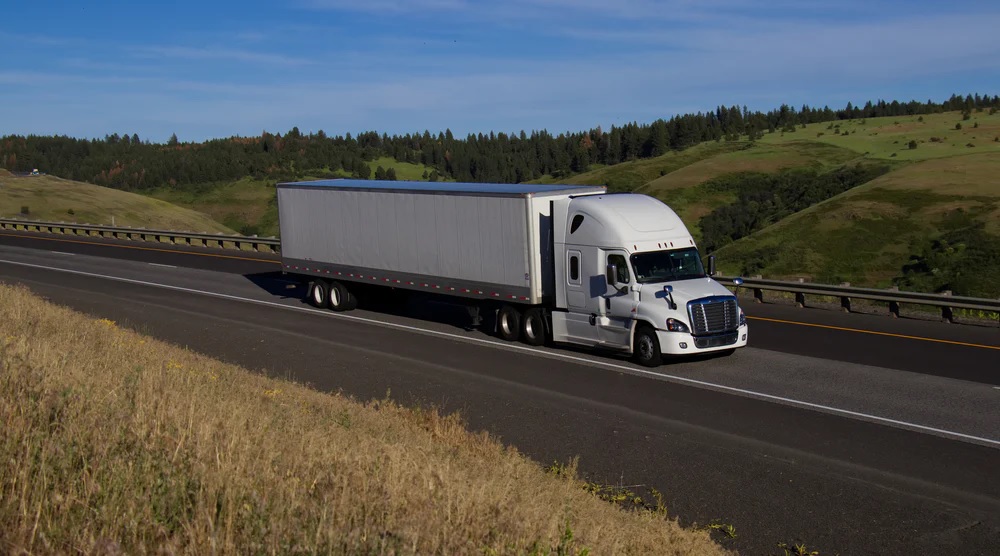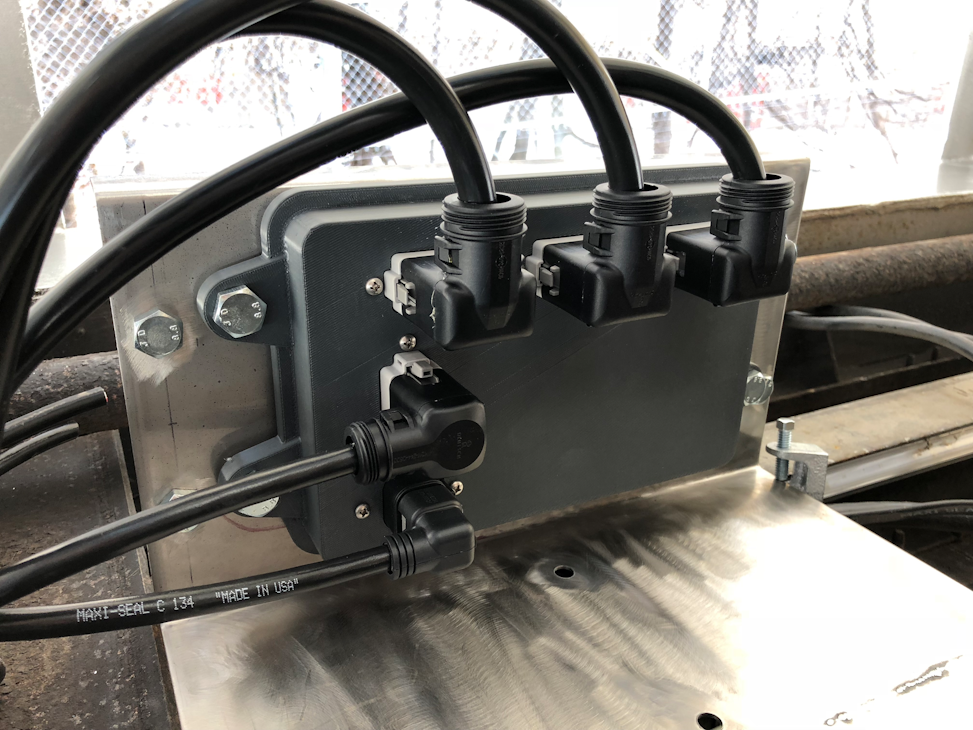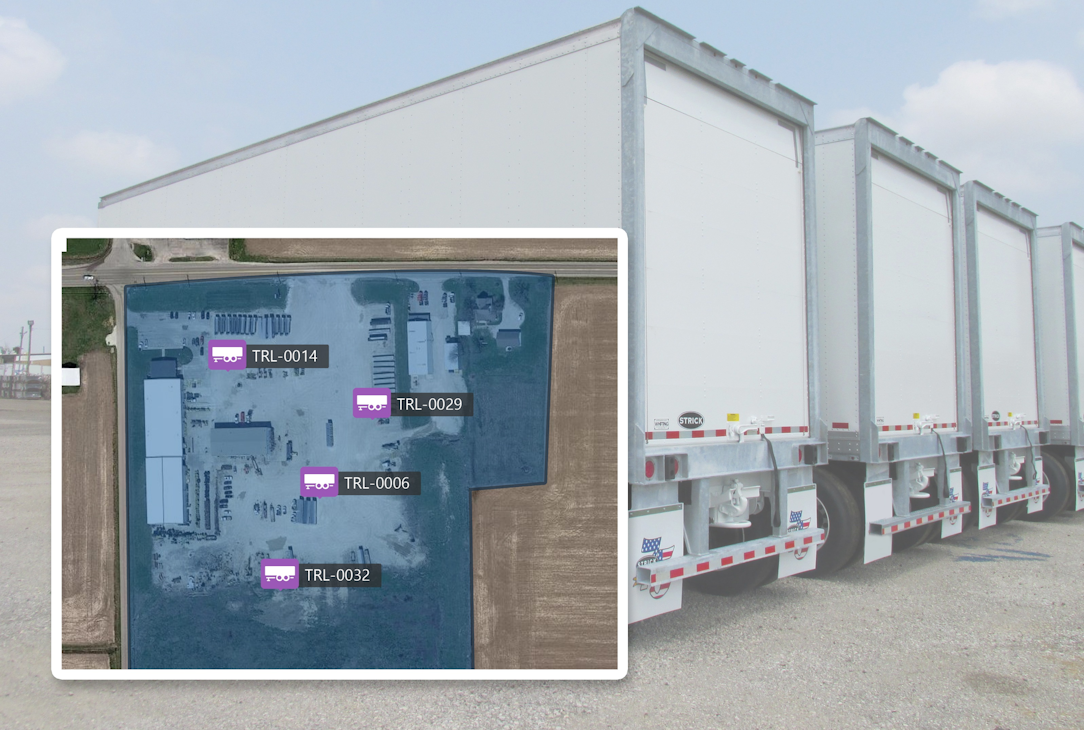Advancements in telematics are helping fleets gain vital insights into their trailers and cargo, helping to reduce maintenance costs, improve uptime, and ensure customer satisfaction.
Telematics has been helping fleets monitor truck location and system performance for many years. Trailers can benefit from this type of technology, too. The good news is that over the past few years, a lot of progress has been made regarding trailer tracking technologies.
“Just a few years ago, trailer telematics was all about, ‘Where’s my trailer?’” said Jim Epler, executive vice president of Phillips Connect Technologies, a provider of intelligent predictive technologies for commercial vehicles. Trailer telematics soon evolved to help track mileage to assist with preventive maintenance scheduling. The evolution continued, ultimately leading to a fleet’s desire to monitor key trailer systems such as brakes, lights, and tires.
“Now we’re taking it one step further,” Epler said. “Now we’re trying to understand how we can help prevent a fleet from dispatching a driver to a trailer that isn’t healthy. A lot of the telematics technology gives a view of what’s happening as it’s happening on the road, which is very important. But we’ve found that having the ability to pre-check a trailer’s brakes, lights, and tires has a lot of value.”
That means sensors are always on, periodically checking the lighting systems, tire pressures, cargo status, and more. “There are a multitude of sensors that should be monitored on a trailer,” Epler said.
The benefits of monitoring are clear.
“The trailer is the asset carrying the valued cargo,” said Lisa Mullen, CEO of Drōv Technologies, provider of the AirBoxOne comprehensive smart trailer solution. “Additionally, there are a myriad of safety concerns on the trailer that affect the operation of the connected vehicle.”
“To maximize trailer use and uptime, and to protect the cargo inside, fleets need to know not only the location of their trailers but also the current status of trailer functions,” said Jeff Geoffroy, director of marketing for Peterson, maker of the PetersonPULSE trailer telematics system. “For instance, if a tractor-trailer is hauling produce, cargo temperature is critical. Trailer telematics can give you real-time confirmation of the required temps.”
“Monitoring and reporting load temp at varying points in the trailer is key to meeting customer requirements based on FSMA (Food Safety Modernization Act) standards,” added Casey Ellis, president of EROAD North America, a provider of fleet management solutions and tracking systems.
Trailer sensors can also monitor ambient temperature, which is directly related to tire pressure.
“Outside temperature can be crucial to interpreting what high or low tire pressure means,” Ellis explained. “Starting a run with low trailer tire pressure in a Minnesota winter requires far different action than low tire pressure in Arizona during July.”
The bottom line is that fleets are now able to track a wide array of trailer functions. Common trailer sensors include:
- GPS tracking
- Lighting
- Cargo door open/closed
- Temperatures
- Tire pressure
- Wheel-end temperature
Some of today’s trailer telematics systems can monitor even more items:
- Wheel-end bearing vibration
- Cargo load capacity
- Brake temperature and wear
- ABS health
- Hard braking events
- Air tank pressure
- Trailer weight
In addition to reading sensors, Mullen said a truly smart trailer solution can also connect to a truck, and even perform certain functions like changing and controlling tire pressure. A smart trailer solution should also be capable of relaying diagnostics to both the driver in the cab and the technician in the shop.
Identify priorities before getting started
When first getting into trailer telematics, a fleet should identify key data points it wants to monitor, and then expand from there as comfort level increases.
“A fleet and its telematics provider must work together to develop the plan,” Peterson’s Geoffroy said. “Identify the problems the fleet is trying to solve, and then identify the key performance indicators (KPIs) that can be measured.”
Although trailer telematics now encompasses more than just trailer tracking, tracking is still a logical place to get started.
“With a trailer tracking solution, fleets can check their trailer locations, pickups, and drop-offs, and even schedule routine maintenance based on specific dates for annual inspections,” said Ryan Driscoll, vice president of marketing at GPS Insight, a provider of GPS tracking, ELD/DVIR, and field service management solutions. “Data is also pulled on time spent in the yard or unused, the time it takes to locate a trailer, maintenance, and other insights to help fleets eliminate waste and become more efficient in workflows while serving more customers.”
Regardless of which items are being tracked, Geoffroy recommended that a fleet place someone in charge of the trailer telematics effort. This person(s) must be invested in the project so they provide the required attention and resources.
“If a fleet can’t get all of these things, what usually happens is that a few trailers are upfitted with the technology, but then they go off into the wild and nobody knows what is happening with them,” Geoffroy said.
Another component to a sound trailer telematics plan is making sure the tracking can expand as fleet needs evolve.
“It’s very important for a fleet to choose a trailer telematics solution that is scalable,” said Rob Phillips, founder and CEO of Phillips Connect Technologies. “The more they see the benefits and potential [of] the sensors, they will want to eventually add.”
Drōv Technologies’ Mullen said that although different fleets may have different priorities, safety is always the common denominator. “Wheel-end information, such as integrated tire management and monitoring, provides every fleet with a great place to start,” Mullen said.
From a preventive maintenance perspective, Geoffroy agreed that tire pressure and wheel-end temperature are important data points for any fleet to monitor.
“This could be an early indication of tire or bearing failure that can lead to unexpected repairs and associated downtime,” Geoffroy said. “A real-time alert could notify drivers of a potential safety issue, allowing dispatchers to schedule an immediate repair.”
ABS fault codes are also helpful to monitor. “We can provide a fault code alert,” Phillips Connect’s Epler pointed out. “But what has become really valuable to fleets is knowing what the specific fault is. Maybe it’s a rear right inner wheel sensor that is reading low psi. Our user interface has that kind of detailed data in it.”
Similarly, the Phillips Connect system monitors wheel-end temperatures and lets the fleet know exactly which wheel is having an issue. “The fleet can see that a specific wheel-end has progressively gotten hotter and should be serviced,” Epler explained.
Tire pressure is another example of where trailer telematics technology has improved.
“ATIS (automatic tire inflation system) was a technology that many fleets bought into years ago,” Epler said. “Now that we’re monitoring tire pressures, we’re also monitoring the regulator that dictates how much pressure is supplied to the tires. Before it was just a guess, oftentimes adjusting a regulator once a year. But what we’ve found is that it is often underinflated or overinflated. Our system will tell you in advance when the regulator is not at optimum pressure and that it needs to be adjusted.”
When getting started with trailer telematics, fleets should think about the complexity of the installation and ongoing maintenance of components.
“Our most popular product, the Smart7, has telematics built right into the nosebox,” Epler pointed out. “That nosebox and harness are installed just like any other.”
“If the harness is assembled correctly and all the pins are properly greased, you typically don’t need to do a lot of maintenance for the life of the trailer,” Phillips added. “Sometimes a technician will need to go in and change a light. That’s a great time to take a wire brush and clean any corrosion you might find, which isn’t likely but can happen if a technician had previously cut into that harness. If that’s the case, clean out the posts, add dielectric grease, put the harness back together, and make sure it’s sealed tight.”
Putting data in the right hands
Once a trailer telematics system is installed and operational, user interface is an important part of making sensor data actionable.
Today’s trailer telematics systems can operate in a variety of ways. Sensors often operate wirelessly, while some are hardwired into the truck’s electrical system. Data can be sent through the cloud to mobile apps, via Bluetooth technology to a device in the cab, or even to the dashboard through the truck’s communication system. Drōv Technologies’ Mullen said a combination of wired and wireless communication protocols are necessary for optimal communication and expandability.
Bluetooth, cellular, and Wi-Fi are all options for wireless trailer-to-cab communications. Mullen offered some insights on each option:
- Cellular—drawbacks include latency (data transfer delay), cost, and intermittent service in rural areas
- Bluetooth—limited on range and doesn’t effectively support video streaming
- Wi-Fi—the best wireless option overall, according to Mullen, but can run into range limitations
With respect to hardwired communications, Peterson’s Geoffroy said a CAN bus harness is an efficient approach. It requires smaller cables and lower power consumption, and is more reliable than wireless networks. CAN bus is also software-agnostic, meaning that a fleet has more choices in the types of sensors it uses.
The PetersonPULSE Intelligent Trailer System taps into a trailer’s existing tracking system, allowing fleets to add additional sensors as desired. Sensor data is sent via CAN bus to a control box on the front of the trailer where it is relayed to a telematics device in the cab.
Phillips Connect has developed partnerships with six telematics providers to expand data accessibility for drivers. “We’re not talking about going through the cloud and sending an email notification,” Epler pointed out. “We’re working with ELD (electronic logging device) providers to make sure these notifications are delivered in real-time to a device in the cab that the driver has great visibility to.”
Phillips Connect’s latest partnership was announced in early June. The EROAD telematics platform now offers the full line of Phillips Connect devices for trailers, including sensors and harnesses.
“Some telematics suppliers focus only on trailer tracking, while others can address a wider range of related needs,” EROAD’s Ellis said. “Having the ability to view trailer data in the same system used for overall fleet management and ELDs can add incredible ROI.”
A fleet should also inquire about reporting capabilities when comparing telematics providers. “If you can’t gather the data, no other feature matters,” Ellis pointed out. “Many suppliers have solutions where as much as 10-15% of telematics devices on trailers aren’t reporting. This provides a huge gap in data, making it hard to achieve any benefits or ROI.”
GPS Insight’s Driscoll said report data should be presented in a way that is easy to digest. “These reports help fleet managers pinpoint where problems lie in their fleets so they can take action quickly,” Driscoll added. “For example, one of our reports can tell you if your trailers are at customer sites or in your yard beyond a set amount of days.”
Providing power to the system
Peterson’s Geoffroy said the most common power supply for a trailer telematics system is a truck’s electrical system via the traditional J560 connector. The one limitation is that there is no power when the trailer is disconnected.
That is why Geoffroy believes battery power is an excellent backup to work in tandem with the electrical system. Fleets should be cautious, though, about overly relying on battery power.
“Charging times can be extended due to low current available from the truck,” Geoffroy pointed out. “Short battery life can also be an issue when disconnected if cellular service in the area is weak. If the battery drains completely, you just lost your trailer data.”
A trailer telematics solution that utilizes multiple modes of power—electrical, battery, and solar—is of benefit to a fleet.
“Each one of these power sources serves as a redundancy to ensure the system can function at all times,” Drōv Technologies’ Mullen said. “Whether it is due to a worn-out socket, bad cable, or blown fuse in the tractor, sometimes trailer power is either intermittent or not available. Solar is obviously not available at night or has reduced power output when it is cloudy, or a trailer is in the shade. Between these two power sources, we are able to either operate our system from those sources or charge the backup battery enough to continue operations.”
Choosing a trailer telematics solution
Even though trailer telematics is still relatively new, there are quite a few providers out there. Peterson’s Geoffroy said fleets should evaluate a telematics provider the same as any critical provider.
“Telematics represents a quickly evolving technology,” Geoffroy said. “Flexibility and collaboration are critical to arriving at a solution that is tailored to each fleet’s unique needs.”
With an eye on the future, longer-term sensor functionality could be an issue. As Geoffroy pointed out, fleets are going through the expiration of 3G truck telematics, which is spurring the need for investment in 4G and 5G systems. With the typical trailer staying in a fleet for seven to 20 years, it’s important for a telematics system to be capable of keeping up with fast-moving advancements in technology.
Geoffroy said a fleet should also inquire about the technology architecture of a telematics system. A closed system is similar to Apple. Apple products work well together, but you must continue to buy Apple products to get seamless integration. An open system, on the other hand, is like Android where the consumer can still choose the hardware and products.
Drōv Technologies’ Mullen said field testing is the best way for a fleet to evaluate different telematics providers. It is best to start by testing those systems and features the fleet wants to begin leveraging right away.
“Fleets need to consider whether the system is providing the solutions or adding third-party suppliers to the solution which can increase costs,” Mullen said. “Another major consideration is to select a provider that has options for expandability in the future. After using our system on a more widespread basis, we often have customers that come up with new use cases for sensors or features to enable a smarter trailer. The driverless future is one that will require a totally integrated smart trailer. Having the ability to meet future demands in the system a fleet chooses today is important.”
This article originally appeared on Fleet Maintenance.
Source: https://www.fleetowner.com/









